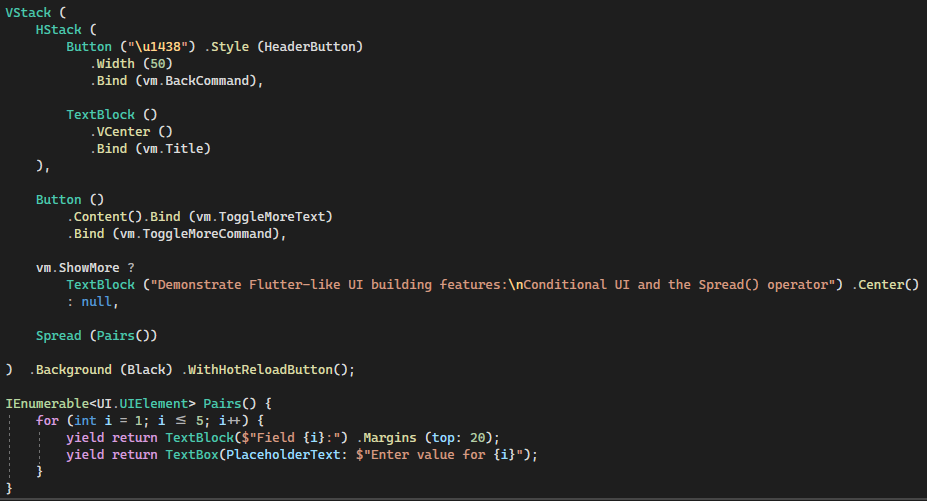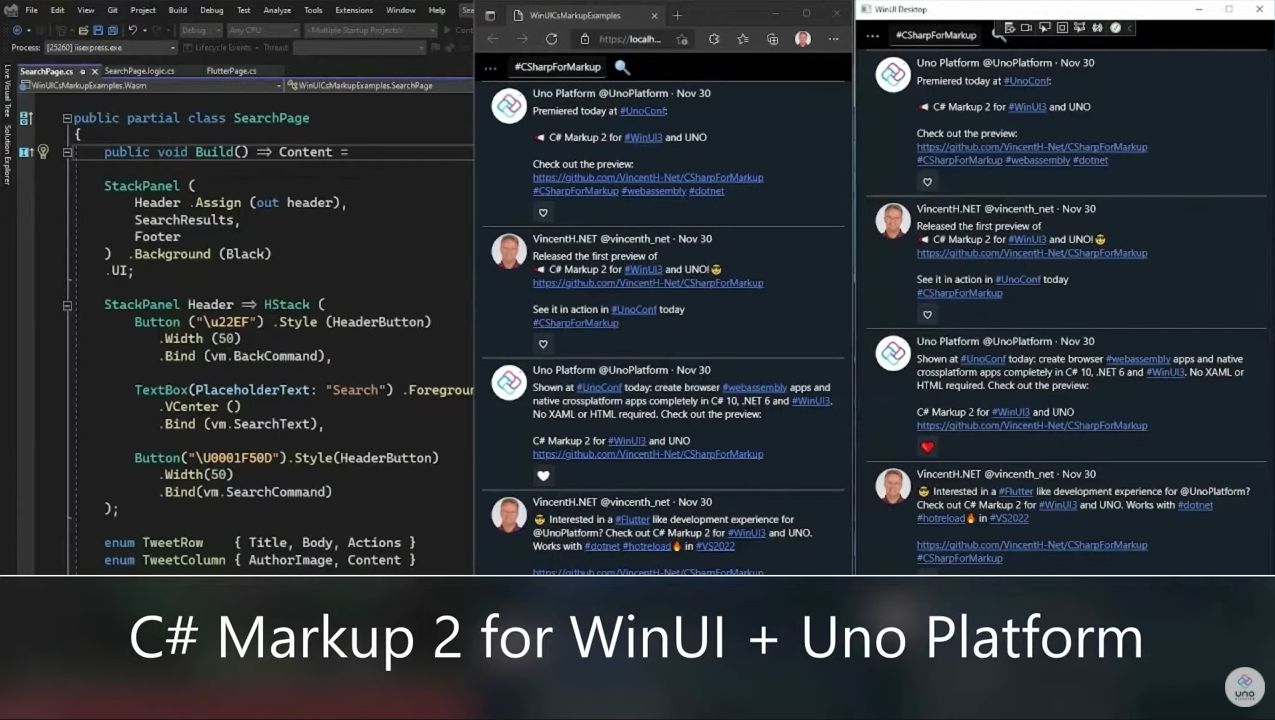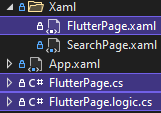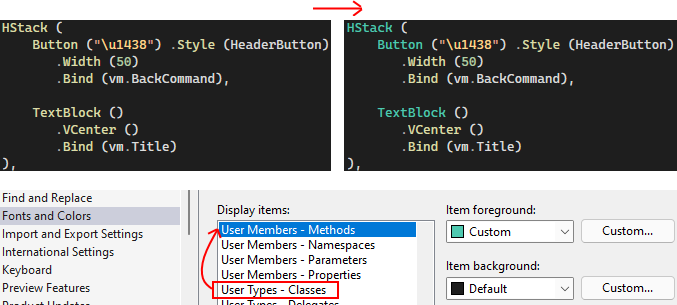C# Markup 2
Enjoy a Flutter-like UI development experience with .NET Hot Reload and the best .NET UI frameworks
- Build .NET applications fully in C#
- Target browsers and native desktop / mobile
No XAML / HTML / JavaScript / CSS required
Looking for C# Markup 1? Find it here
News
November 30, 2021
C# Markup 2 announced at UNOCONF 2021!
This first preview targets WinUI 3 and Uno Platform - including browser webassembly - with C# 10 and .NET 6. It supports .NET Hot Reload for a fast inner dev loop.
Getting started with C# Markup 2 for WinUI and Uno Platform
First check if your development environment is ready for Uno Platform and WinUI 3:
Work with the example solution
- Clone this repo
- Open CSharpMarkup.WinUI.Examples.sln
- Explore the example pages in the
Examples.Sharedproject - Debug the
Examples.Wasmor theExamples.Windows.Desktopproject - To use hot reload in VS2022 Preview:
To learn how to use C# Markup 2, see the features description below.
Features
C# Markup 2 contains a full declarative, fluent API for WinUI 3. It surfaces virtually every DependencyObject and DependencyProperty in WinUI 3, including attached properties, and includes full inline documentation that links each markup helper to the inline documentation for the underlying WinUI object / property.
The rich WinUI 3 framework that C# Markup 2 surfaces contains 500+ bindable object types. Layouts, views and styles, but also brushes, rich text elements, drawing primitives, transformations, animations, visual states and more. In addition C# Markup offers powerful and concise convenience API's for layout, bindings, convertors, templates and more.
- When targeting Windows Desktop, the WinUI API from Windows App SDK is surfaced (without any dependency on Uno Platform).
- When targeting Uno Platform, the Uno.WinUI API is surfaced (atm only webassembly is tested, but any Uno target platform that can support .NET 6 and C# 10 should work)
See C# Markup features in action in the CSharpMarkup.WinUI.Examples solution in this repo.
NOTE - this is an early preview, intended mainly to gauge interest and to get feedback on the shape and features of the markup API. NJoy playing around with this and chime in with issues if you like / want things or if you have questions.
Twitter feedback is also welcome - use #CSharpForMarkup and @vincenth_net, thanks!
Only Windows Desktop and webassembly targets have been tested at this time, and there has been no webassembly performance optimization so far. Expect frequent updates in the coming weeks!
Basic markup anatomy
Layouts, views, properties and property values look like this:
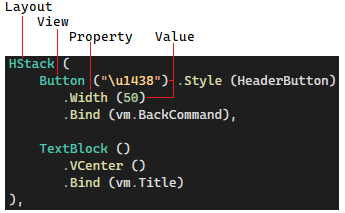
All properties can be set with extension methods - properties defined on the view type or it's base types, as well as attached properties.
Properties that are defined directly on the view type can alternatively be set with named parameters:
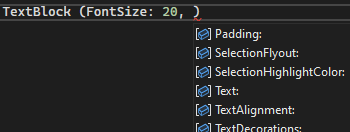
This is mainly useful for properties that take primitive types.
Properties that take enum values have extension methods so the enum name does not have to be repeated
(as in TextAlignment: TextAlignment.Center):
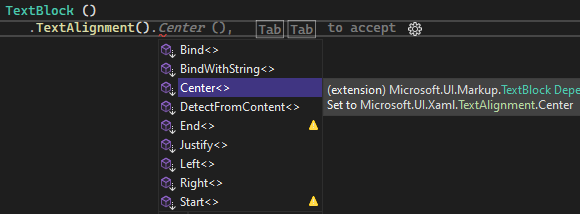
Attached property names are prefixed with the defining type plus underscore:
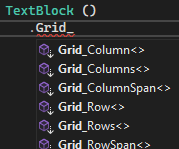
In addition to this, there are convenience overloads for some view types with just the most commonly used parameters:

Styles
Styles can be assigned like this:

Templates
Templates are passed in as a Func<UIElement>:

Enums for Grid rows and columns
You can use enums instead of numbers for Grid rows and colums. This improves readability and saves you from manually renumbering rows and columns when adding/removing/reordering them

Shorthand helpers
Shorthand helpers are included as an alternative to common combinations of markup helpers:
Insert layout children: conditional and Spread
All layouts ignore null values in their children; this makes it possible to have conditional views depending on the value of an expression at page (re) build time.
The Spread helper allows to insert a variable number of children at a specific position in the children list (similar to what Flutter offers).
Binding power
Thanks to C# 10, you don't have to use strings or nameof() to specify binding paths with good performance :

Note that the pathExpression parameter supports several convenience binding syntaxes; see it's intellisense description in above image.
Bind supports almost all functionality that WinUI 3 offers for binding. In addition, there are many Bind overloads that offer:
- Omit the property name to bind to the default property of a view type:

- Bind with inline conversion:

- Bind a command and it's parameter in one go:

Page anatomy - separate markup and UI logic
A typical markup page starts like this:
FlutterPage.cs:
using Microsoft.UI.Markup;
using static Microsoft.UI.Markup.Helpers;
namespace WinUICsMarkupExamples;
public partial class FlutterPage
{
public void Build() => Content = Note the use of partial class; this lets you separate the UI markup from UI logic:
FlutterPage.logic.cs:
using Microsoft.UI.Xaml.Controls;
namespace WinUICsMarkupExamples;
public sealed partial class FlutterPage : Page, IBuild
{
readonly FlutterViewModel vm;
public FlutterPage()
{
InitializeComponent();
DataContext = vm = App.Current.FlutterViewModel;
Build();Note at the moment WinUI still requires that you have a XAML file for a page. It only needs to contain an empty
Pageelement though, and you can move those files out of sight in a folder, e.g.Xaml:
Integrate UI markup with UI logic
With Assign and Invoke you can integrate UI markup with UI logic:
Note: in code behind do NOT use Microsoft.UI.Markup, only the UI object model.
Due to a performance preservation mechanism in Markup objects, Markup object instances are not safe to use outside of a markup expression.
That is why Assign and Invoke pass the UI object to the logic, not the markup object.
Development workflow tips
Improve markup colorization in Visual Studio
There is no C# Markup IDE extension (yet...) to properly colorize markup, however C# Markup readability can be improved with this workaround in Visual Studio options:
Under Fonts and Colors, copy the color of User Types - Classes to User Members - Methods (with the Custom... button). Now the markup color for views and properties will no longer be the same.
Fast inner dev loop with .NET Hot Reload
Get the fastest inner dev loop for C# Markup 2 by using .NET Hot Reload in Visual Studio 2022 Preview, targeting Windows.Desktop (packaged). Even when you are not targeting Windows, this is good for getting most of your UI build work done as quickly as possible. Switch to other target(s) to finetune and test.
Since at this moment detecting hot reload in WinUI 3 is broken in .NET SDK, a workaround is to conditionally add a hot reload button on your pages for a debug Windows build. The example contains a .WithHotReloadButton() extension method to do this.
